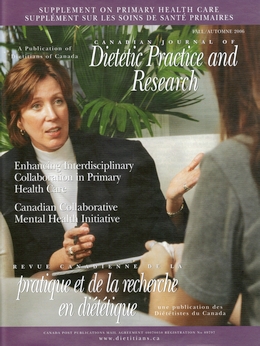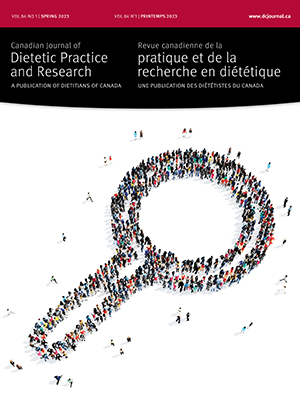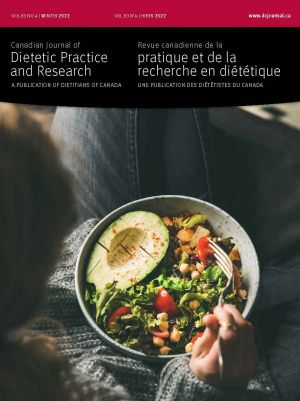Volume 67 • Number 3 • September 2006
Chair’s Message
Editor’s Message
Research
Purpose: The concept of “client-centredness” was explored within a nutrition counselling relationship. Methods: A two-round reactive Delphi survey was used. The first survey was sent to 65 Dietitians of Canada members who indicated in the member database that they had advanced counselling skills. Following analysis of the data, the secondround questionnaire was developed and sent to participants with a report of the first-round results. Analysis of the secondround survey indicated that participants’ responses had remained stable, and the Delphi survey was terminated. Results: Participants agreed that most of the issues identified in the Delphi questionnaire should be included in a client-centred approach to practice; however, when participants were asked about their experience in these areas, median responses and/ or the interquartile ranges changed, indicating some difficulty in implementing the client-centred approach. Comments also indicated that the reality of their workplaces did not allow participants to be as client-centred as they thought they should be, and suggested that the concept of “client-centredness” is not universally understood by dietitians. Conclusion: If a client-centred approach to practice is truly important, we need to start a dialogue within the profession to gain a deeper understanding of what this means and how it can be implemented.
Purpose: Childhood obesity is a public health concern in Canada. Few published anthropometric data are available to indicate obesity prevalence in Canadian children. Obesity prevalence is reported for school-aged children in 11 London, Ontario, schools. Methods: Data on body weight and height were obtained using standardized procedures. United States Centers for Disease Control and Prevention (CDC) body mass index (BMI)-for-age references and Cole’s international BMI reference were used to classify the children’s weight categories. Results: The study included 1,570 pupils aged six to 13. The CDC BMI references categorized 16.6% and 11.8% of children as overweight and obese, respectively. In comparison, when the Cole BMI reference and cut-off points were used, 17.5% and 7.6% of children were classified as overweight and obese, respectively. Conclusion: Overweight is prevalent in the study population. Public health interventions are warranted to curb the obesity epidemic in school-aged children.
Review
Overview: Iron is an essential nutrient, playing a central role in oxygen transport and cellular energy metabolism. The importance of ensuring adequate bioavailable dietary iron stems from the severe consequences associated with iron deficiency (ID) and anemia, including reduced immune function and resistance to infection, developmental delays and irreversible cognitive deficits in young children, impaired physical work performance, and adverse pregnancy outcomes. Specific populations: Poor dietary iron intake and ID exist in Canada, particularly in women of reproductive age. Data from the provincial nutrition surveys suggest that the prevalence of inadequate iron intakes (and low intakes of absorbable iron) among women under 50 years of age is over 10%, which may reflect poor iron status. Teenage girls are at risk for low iron stores because of the adolescent growth spurt and the onset of menstruation; those who are vegetarian are at even greater risk. Conclusions: The Canadian diet has changed so that grain products are now the main source of dietary iron for all age groups. The public must be educated to ensure the consumption of adequate quantities of bioavailable iron and enhancing factors such as vitamin C. Industry, government, and health professionals must work together to promote healthy eating patterns and the selection of appropriate foods.
Report
Purpose: In Canada, the incidence of childhood obesity has tripled within the past 20 years. The prevalence of obesity in the Timmins, Ontario, student population was studied to gain knowledge for program planning and resource allocation, and to compare Centers for Disease Control and Prevention (CDC) criteria with Cole’s international criteria for childhood obesity. Methods: Anthropometric measurements of 801 students were taken. Students were chosen from randomly selected schools for each grade. Data were analyzed according to age, gender, and ethnicity. Data were also compared with other studies. Intragroup comparisons were performed using hypothesis testing for significance with the z table and chi-square test. Results: Overweight and obesity prevalence was 28% according to CDC criteria. No statistical difference was found between genders or among ethnic groups, or between this study and other Canadian studies. In comparison with the CDC criteria, Cole’s international criteria indicated less obesity and increased overweight prevalence. These differences were not statistically significant. Conclusions: The findings suggest that in the northern Ontario community of Timmins, the prevalence of childhood obesity is of epidemic proportions. When the findings are shared with different agencies, this study will help the health unit to take necessary public health measures to curb the epidemic.
Recognition
OPEN ACCESS
Background: The 21st-century model of health research is founded on a broad base of multidisciplinary research that is expeditiously and effectively translated into evidence-based practice, education, policy, and advocacy. The key objective is to improve the health of populations. Dietitians’ roles: Dietitians, whether they are working in clinical or public health nutrition or food science, have a vital role to play in this paradigm of health research. As dietitians’ roles have evolved beyond the traditional ones into subspecialties including epidemiology, nutrigenomics, functional foods, nutraceuticals, toxicology, natural health products, and multidisciplinary research, the need for advanced training in subspecialty fields has become essential. Opportunities: A dietetics background is an excellent foundation upon which to develop a research career in one of these new areas of nutrition. Opportunities for personnel awards and research funding targeted at nutrition clinician-scientists and other nutrition subspecialists have grown tremendously in recent years. Conclusion: The information in this paper is intended to inspire dietitians seeking advanced academic training in one of the new exciting avenues for a career in nutrition. These avenues will permit dietitians to contribute to knowledge discovery, translation, and outreach to improve the nutritional status and health of populations in Canada and globally.










